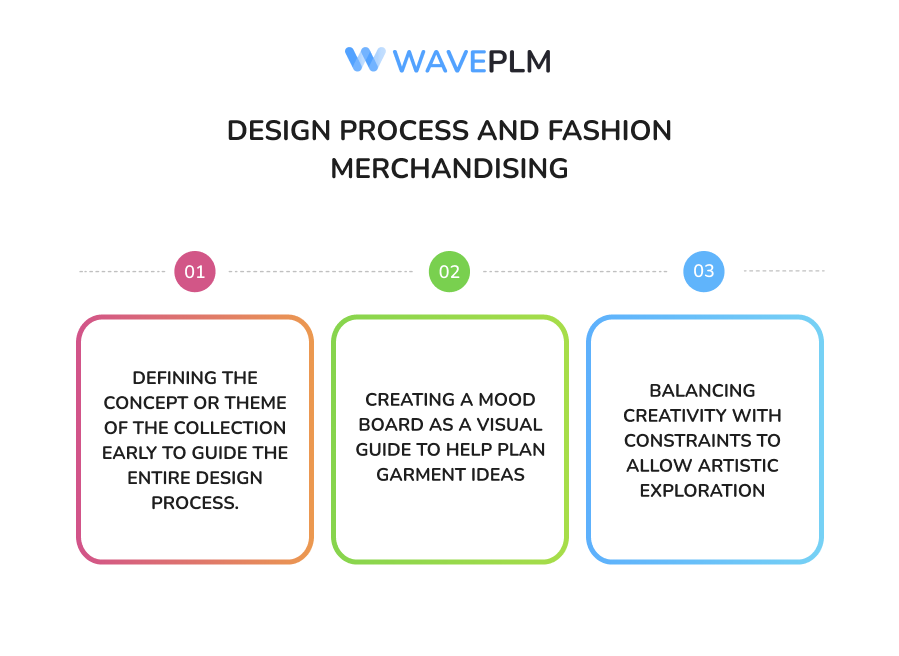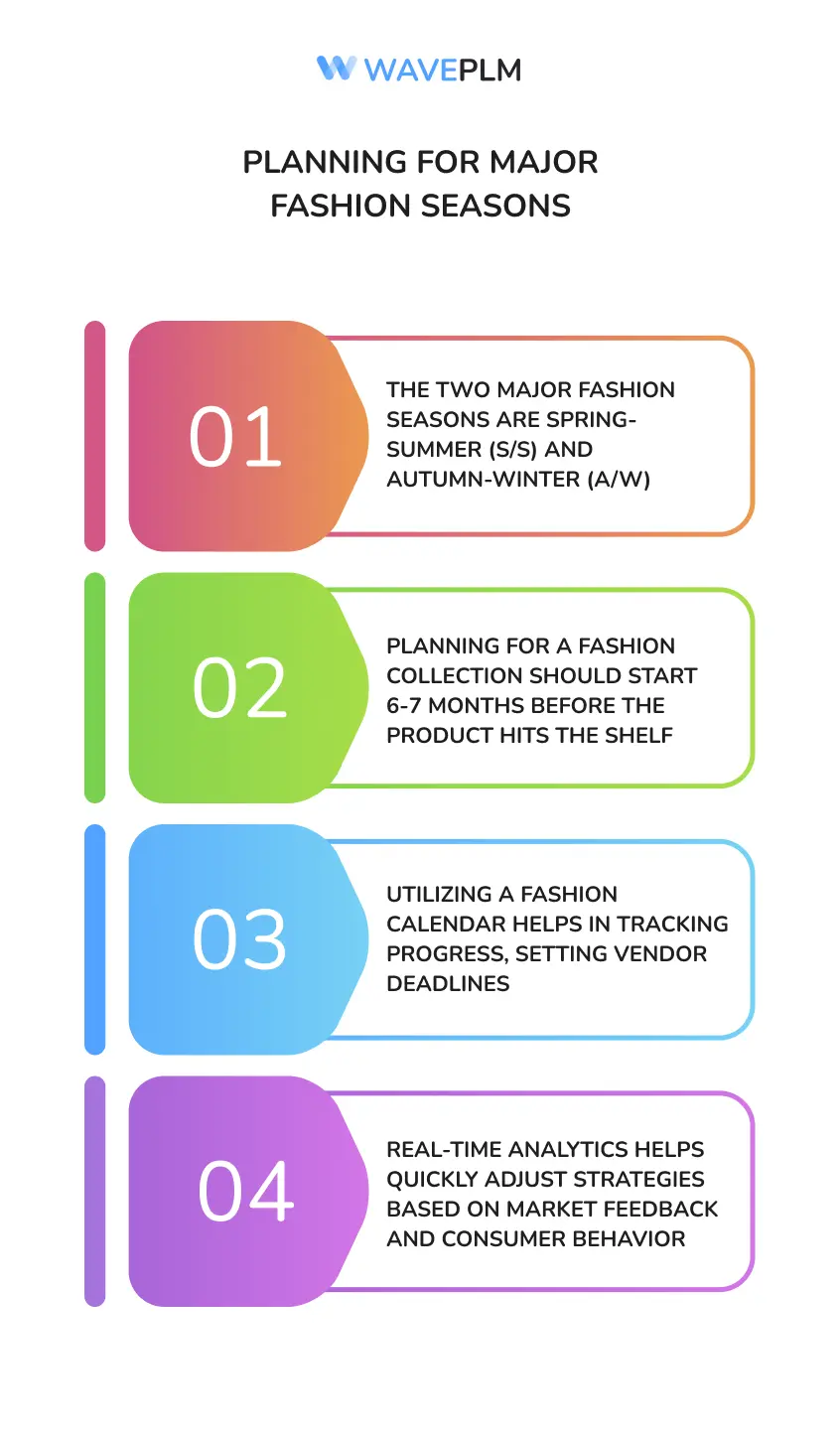
Effective fashion planning is key to creating a successful collection. This involves setting clear goals, understanding market trends, and managing resources effectively. This article will provide you with essential steps and tips to excel in fashion planning and make your collection market-ready.
Key Takeaways
- Fashion planning is essential for creating a cohesive collection that effectively connects with the target audience and enhances brand identity.
- Key steps in fashion planning include defining a clear vision, researching market trends, and aligning with brand values to ensure competitiveness.
- Utilizing technology and data-driven strategies plays a critical role in streamlining fashion planning processes and adapting to market changes.
Understanding Fashion Planning

Fashion planning is the cornerstone of a successful fashion business. It involves creating a cohesive set of pieces that work together harmoniously, ensuring a consistent look and feel for your brand. A meticulous fashion collection plan serves as the foundation for your brand’s identity, helping you control costs, meet deadlines, and allocate resources effectively. Aligning your collection with market trends ensures your designs remain relevant and resonate with your target audience.
At its core, fashion planning is about understanding and anticipating customer preferences. This involves researching fashion trends for inspiration, identifying successful design aesthetics, and incorporating innovative elements that make your collection stand out in a competitive market.
Understanding your target audience ensures your collection connects with the right consumers. A comprehensive fashion plan not only guides designers but also helps in controlling various aspects such as costs, deadlines, and resources, ultimately leading to a successful fashion collection.
Crafting an Effective Fashion Plan
Crafting a successful fashion plan involves defining your vision and goals, researching market trends and competitors, and aligning with your brand identity. Balancing current fashion trends with your brand’s unique identity and engaging customers is crucial.
Each of these steps plays a vital role in ensuring that your fashion business stays relevant and competitive in the ever-evolving fashion industry, according to fashion industry experts.

Defining Your Vision and Goals
Defining your vision and goals is the initial and most crucial step in crafting a fashion plan. This involves outlining the overall vision for your collection and identifying your target audience. A clear understanding of your goals will guide your design choices and help you stay focused throughout the planning process. Establishing a specific concept for your collection will resonate with your audience and enhance brand awareness.
Setting clear and achievable goals provides your team with a roadmap that aligns with your business plan. This helps in maintaining focus and ensures that every design decision supports your overall vision, allowing you to decide on the best course of action.
Whether your aim is to break into a new market or reinforce your brand’s identity, having well-defined goals will make the planning process more structured and effective. Remember, a strong vision and clear goals are the bedrock of any successful fashion collection.
Researching Market Trends and Competitors
Researching market trends and competitors is crucial during fashion planning. Understanding your target audience is crucial for focusing your design aesthetic and creating a cohesive collection that resonates with consumers. Incorporating audience preferences into your collection plan increases the likelihood of market success by offering products that meet consumer demands. Analyzing market trends, buying patterns, and competitor strategies enables you to position your collection competitively.
Various sources such as fashion magazines, online stores, and fashion bloggers can provide valuable insights into the latest trends. Competitor analysis helps you track your performance against industry standards and adjust your strategies accordingly.
Integrating insights from audience research, trend analysis, and competitor assessment refines your fashion plan to better meet market demands and stand out in a crowded industry.
Aligning with Brand Identity
Your fashion plan must reflect your brand identity to create a collection that resonates with your intended audience. A successful fashion plan must reflect your brand’s core values, ensuring consistency across all pieces. This consistency helps in capturing the attention of your target audience and building a strong brand image.
Maintaining a consistent brand image across all platforms is crucial for effective marketing. This involves ensuring that your collection aligns with your brand’s established identity and values. If your brand is known for sustainable fashion, your collection should emphasize eco-friendly materials and practices.
This alignment not only strengthens your brand’s growth but also provides a competitive advantage in the market. Staying true to your fashion brand identity helps create a cohesive and impactful fashion collection.
Key Elements of Fashion Planning

Recognizing the key elements of fashion planning is crucial for creating a successful fashion collection. These elements include establishing a clear product mix, structuring the design process, and maintaining a precise production schedule. Each of these components plays a vital role in ensuring that your fashion business operates smoothly and meets market demands.
We’ll explore these key elements additionally in more detail.
Product Mix and Assortment Planning
Product mix and assortment planning are fundamental aspects of fashion planning. A well-thought-out assortment plan considers:
- Styles
- Trends
- Sizes
- Colors
- Locations
This strategic approach helps in maximizing sales and optimizing inventory management.
Data analytics and AI-driven insights can further enhance assortment planning by:
- Identifying emerging trends
- Optimizing pricing and inventory strategies.
A successful fashion assortment plan balances structure with flexibility to respond to evolving market trends and customer preferences. Regular updates, typically every couple of months, keep your collection relevant.
The appropriate size of a fashion collection, usually around 12 to 20 pieces, helps maintain a manageable assortment while catering to regional preferences and staying relevant in the market.
Design Process and Fashion Merchandising
The design process and fashion merchandising are critical for aligning product aesthetics with market demands. Key steps include:
- Defining the concept or theme of the collection early to guide the entire design process.
- Creating a mood board as a visual guide to help plan garment ideas.
- Balancing creativity with constraints to allow artistic exploration while ensuring practicality and comfort based on the intended use of the pieces.
Sampling during the fashion production process is crucial for ensuring quality and minimizing errors. Testing fabrics and inspecting samples help in identifying needed changes before final production. Tools like Fashion Techpacks aid in this process by providing detailed specifications for each piece.
Completing all embellishments before showcasing items at a fashion show is vital for a successful collection. This thorough approach to the design process and fashion merchandising ensures the entire process results in a cohesive and market-relevant collection.

Production Schedule and Supply Chain Management
A well-organized production schedule and effective supply chain management are crucial for the timely delivery and quality of your fashion collection. Key points include:
- Defining production deadlines to coordinate marketing materials and product descriptions.
- Managing all production stages to avoid surprises and ensure timely completion.
- Synchronizing production timelines with market release strategies through effective supply chain management.
- Optimizing inventory management.
Establishing reliable partnerships with suppliers ensures the quality of materials and timely delivery, which are vital for maintaining standards. Personal factory visits can help ensure that quality standards are consistently met.
Data-driven strategies streamline inventory management by accurately forecasting demand, leading to better inventory levels and reduced stockouts. Incorporating quality control measures during the production phase helps maintain the consistency and quality of the final product.
Utilizing Technology in Fashion Planning

In today’s fast-paced fashion industry, utilizing technology in fashion planning is essential for streamlining processes and improving brand responsiveness. Fashion software solutions and data-driven decision-making tools play a significant role in enhancing the efficiency and effectiveness of fashion planning.
Let’s explore these technological advancements in more detail.
Fashion Software Solutions
Fashion software solutions are indispensable for aiding assortment planning, inventory management, and design collaboration within the fashion industry. Examples include:
- Audaces Isa: Enables online collection planning and facilitates real-time collaboration among teams.
- Online sketching tools: Enhance creativity and precision by allowing team members to view and share design concepts easily.
- Wave PLM: Streamlines product design and sourcing, reducing time to market and development costs.
Tools like CLO 3D provide a 3D visualization of garments, aiding in design accuracy and reducing the costs of physical samples.
Collectively, these software solutions greatly enhance the efficiency of assortment planning and inventory management processes, leading to a successful fashion collection and improving the allocation process.
Data-Driven Decision Making
Leveraging historical data allows fashion planners to make informed decisions based on past consumer behavior and trends. Data helps predict demand, identify trends, and optimize inventory levels for better assortment planning.
Integrating real-time analytics provides valuable insights that enhance decision-making capabilities and enable timely adjustments in inventory and marketing strategies. By utilizing data-driven decision-making tools, fashion brands can stay ahead of market changes and maintain a competitive edge.
Adapting to Seasonal Changes

Adapting to seasonal changes is a vital aspect of fashion planning. Through shifts in store displays and product placement, seasonal changes are effectively reflected in fashion assortment planning. Retailers can utilize real-time inventory tracking and demand forecasting to adapt their assortment plan to trends, ensuring timely and relevant offerings.
Let’s delve into the specifics of planning for major fashion seasons and incorporating seasonless fashion.
Planning for Major Fashion Seasons
Ensuring that fashion planning aligns with major seasons maximizes sales potential and improves supply chain efficiency. Key points to consider include:
- The two major fashion seasons are Spring-Summer (S/S) and Autumn-Winter (A/W).
- Planning for a fashion collection should start 6-7 months before the product hits the shelf.
- Utilizing a fashion calendar helps in tracking progress, setting vendor deadlines, and implementing strategies.
- Real-time analytics enable fashion brands to quickly adjust strategies based on market feedback and consumer behavior.
Historical sales data is invaluable in informing future trends and minimizing overproduction and stock-outs. By aligning your fashion plan with major seasons, you can ensure that your inventory is ready at the right time to meet consumer demand. This strategic approach helps in maximizing sales and maintaining efficient supply chain management to sell through effectively.

Incorporating Seasonless Fashion
Seasonless fashion is a growing trend in the industry, offering versatility and adaptability across different climates and consumer needs. Creating a seasonless collection involves developing pieces that can be worn year-round, transcending traditional seasonal boundaries. This approach not only caters to the global market but also reduces the risk of overproduction and stockouts associated with seasonal fashion.
Focusing on timeless styles and high-quality materials ensures that your collection remains relevant throughout the year. This strategy allows fashion brands and other brands to create a cohesive collection that appeals to a broader audience, ultimately leading to increased sales and customer satisfaction.
Incorporating season fashion into your planning can provide a competitive edge and enhance the sustainability of your fashion business.
Marketing Strategies for Fashion Planning
Effective marketing strategies are essential for showcasing your fashion collection and maximizing sales. Establishing key performance indicators (KPIs) and regularly assessing sales performance and customer responses are crucial for recognizing areas that require adjustments in your selling fashion business strategy.
Let’s explore the importance of creating a marketing plan and leveraging social media and influencers to enhance your fashion planning.
Creating a Marketing Plan
Creating a comprehensive marketing plan is vital for the successful launch of your fashion collection. This plan should include:
- A timeline that outlines promotional activities leading up to and following the launch.
- Ensuring you have business cards organized.
- Having a website set up.
- Creating an Instagram page to enhance your brand’s visibility before showcasing your collection.
A well-crafted marketing plan incorporates various marketing strategies, such as assortment planning, to maximize sales and optimize inventory management. Strategically allocating resources and setting clear goals helps create a cohesive and effective marketing plan that supports your overall business objectives. This approach not only drives sales but also strengthens your brand’s presence in the competitive fashion industry.
Leveraging Social Media and Influencers
Leveraging social media and influencers is a powerful strategy for expanding your brand’s reach and engagement. Collaborating with well-known fashion influencers can significantly enhance your brand’s visibility and credibility. Influencers who align with your brand values can help expand your audience and lend credibility to your fashion collection.
Platforms like TikTok have shown significant engagement rates, making them particularly effective for connecting creators with audiences. Utilizing social media platforms effectively can dramatically boost your brand’s visibility and customer engagement, leading to increased sales and brand loyalty.
Incorporating influencer marketing into your strategy amplifies your reach and establishes a strong presence in the fashion industry.
Measuring Success and Refining Your Plan
Measuring success and refining your fashion plan are essential for continuous improvement and maintaining competitiveness. Setting clear metrics for performance and outcomes helps in evaluating the effectiveness of your strategies.
Let’s explore the importance of analyzing sales and customer feedback and the benefits of continuous improvement and adaptation.
Analyzing Sales and Customer Feedback
Analyzing sales data and customer feedback is crucial for optimizing your fashion plan. Tools and methods include:
- WovenInsights, which provides analytics to help optimize product assortments and enhance decision-making.
- Sales data analysis, which helps gauge customer preferences and adjust future product offerings accordingly.
- Collecting customer feedback after purchases, which provides insights into satisfaction and areas for product improvement.
Combining insights from sales data and customer feedback allows fashion brands to refine their strategies and develop a more targeted approach to their collections. Customer feedback can highlight gaps in service and product offerings that need addressing for future collections. This continuous evaluation ensures that your fashion plan remains relevant and effective in meeting market demands.
Continuous Improvement and Adaptation
Continuous improvement and adaptation are key to maintaining a competitive advantage in the fashion industry. Regularly revisiting and refining strategies based on market trends ensures relevance and competitiveness. Flexibility in fashion planning allows brands to quickly respond to changing consumer demands and preferences.
Adopting a flexible and iterative approach to fashion planning is crucial for sustaining relevance in a dynamic market. Embracing this approach helps fashion businesses stay ahead of market trends and maintain a competitive edge.
Continuous improvement enhances the quality of your fashion collections and ensures long-term success in the ever-evolving fashion industry, paving the way for your next collection.
Summary
In conclusion, successful fashion planning requires a meticulous and strategic approach. From defining your vision and researching market trends to leveraging technology and adapting to seasonal changes, each step plays a crucial role in creating a cohesive and impactful fashion collection. By continuously measuring success and refining your plan, you can ensure that your fashion business remains relevant and competitive. Embrace these top tips for successful fashion planning, and let your creativity and strategic thinking pave the way for your brand’s growth and success in the fashion industry.
Frequently Asked Questions
Why is a fashion collection plan important?
A fashion collection plan is crucial as it establishes cohesion, shapes brand identity, and guarantees a consistent aesthetic across all designs. This foundational element is essential for successful branding and consumer recognition.
How do I define the vision and goals for my fashion collection?
To effectively define the vision and goals for your fashion collection, outline the overall vision, identify your target audience, establish specific concepts, and set clear goals that will guide both your design choices and marketing strategies. This structured approach ensures coherence and focus throughout the development process.
What role does technology play in fashion planning?
Technology plays a crucial role in fashion planning by streamlining processes, improving efficiency, and enhancing brand responsiveness through the use of fashion software solutions and data-driven decision-making tools. This integration ultimately allows brands to make more informed decisions and adapt quickly to market trends.
How can I adapt my fashion collection to seasonal changes?
To effectively adapt your fashion collection to seasonal changes, align your planning with major seasons, utilize real-time analytics for strategy adjustments, and incorporate seasonless fashion for enhanced versatility.
What are some effective marketing strategies for a fashion collection?
An effective marketing strategy for a fashion collection involves developing a comprehensive plan that outlines clear timelines and promotional activities, while also leveraging social media and influencers to enhance brand visibility and engagement. Prioritizing these elements will significantly improve your marketing efforts.





Leave a Reply